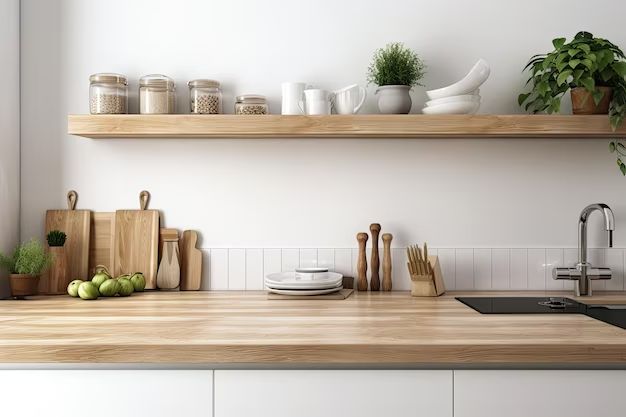Installing a floating counter in your kitchen can be a great way to add extra seating and work space. However, since floating counters aren’t connected to the ground, they require some special considerations for support and installation. In this article, we’ll walk through the process of installing and supporting a floating counter so it is stable, level, and safe to use.
Page Contents
What is a floating counter?
A floating counter, also sometimes called an island counter or peninsula counter, is a work surface that isn’t connected to any walls. Floating counters stand alone, typically connected only by a base on the floor. This gives them a lightweight, airy appearance, as if they are “floating” in the middle of the room.
Floating counters are commonly used in kitchens to provide extra prep space, casual seating, and visual interest. They can also be utilized in bars, home offices, and other rooms as standalone work stations or tables.
Benefits of using a floating counter
There are several advantages that make floating counters a popular choice:
- They open up floor space and allow traffic flow around them.
- They can be positioned wherever needed or reconfigured to adapt to changing needs.
- They provide a second, standalone work surface for food prep, serving, office tasks, etc.
- They create an area for casual dining/seating.
- They provide visual interest and dimension to a room.
Challenges of floating counters
While floating counters offer versatility, their unconventional freestanding design also comes with some unique considerations:
- They can’t rely on attachment to walls for support, so their structure must be strong enough to stand on its own.
- All structural support must come from the base and/or underside reinforcements.
- The counter top needs to be properly secured to the base.
- The structure has to be level and well-balanced.
- It’s important to account for potential settling or shifting over time.
Proper installation is key to creating a floating counter that is safe and stable for everyday use.
How to install a floating counter
Here is an overview of the typical installation process:
Select a location
Choose a space with enough square footage for the counter’s footprint plus comfortable clearance around it. Make sure plumbing and electrical needs can be met.
Build a base
The base provides primary structural support. It should be made of sturdy material like wood, steel, or laminate. The base shape depends on counter design – common options are:
- Cabinet-style base
- Table-style legs at corners
- Floor-mounted pedestal
- Metal pipes or framed trestle
Build the base precisely to final counter height and dimensions.
Anchor the base
The base should be securely anchored in place. This prevents wobbling or shifting later on.
Fasten floor-mounted bases using appropriate hardware based on flooring type. With cabinet bases, anchor to the floor by attaching angle iron braces inside corners.
Add support framework
Additional framing helps stiffen and strengthen the structure:
- Attach corner gussets between table legs.
- Install an apron frame around cabinet bases.
- Connect cross bracing between legs or side panels.
Secure the counter top
The counter top should be a high quality material with sufficient thickness to span unsupported areas and hold weight without sagging.
Carefully position the top and shim as needed to make it level. Secure using corner blocks, angle brackets, adhesive, and/or screws from below. Apply caulk along the seam between counter and base.
Check for levelness & stability
Double-check that the counter is evenly level and solidly supported. Try gently rocking or nudging the edge to test for any instability. Make any necessary final adjustments.
How to add support to an existing floating counter
For a floating counter that is already installed but needs reinforcement:
Check where it is sagging or unstable
Examine areas on the counter top that dip down, bounce, or feel weaker when pressed down. This indicates where additional support is needed.
Access the underside
You’ll need to work from underneath to shore up the weak spots. If it’s a cabinet-base counter, you may need to remove drawers or a center panel on the base cabinet to get internal access.
Add framework
Add bracing or panels between base units to improve side-to-side stability. Install crossbeams beneath the counter top to prevent sagging. Secure these with construction adhesive and screws into underside of the top.
Add corner supports
For a counter on table legs, attach metal L-brackets or 2×4 blocks where needed to reinforce the leg-top connection at corners.
Attach an apron
Adding a decorative apron around the exposed base edges can also help stiffen the piece.
Adjust or shim as needed
Use shims to make the counter level again if reinforcing has caused height differences. Adjust joinery connections that have loosened over time.
Tips for preventing sagging
Here are some extra recommendations for keeping a floating counter sturdy and level for the long term:
- Select a 3/4″ thick wood top or 1″ thick natural stone top.
- Keep unsupported spans under 60″ between base units or legs.
- Allow an overhang of no more than 12″ beyond base support.
- Choose a water-resistant base material like laminate over plain particleboard.
- Use central support pedestals or floor joists under longer counters.
- Reinforce the frame with corner gussets and cross bracing.
- Check levelness annually and make any needed adjustments immediately.
Conclusion
Installing a floating counter is an intermediate skill-level project that’s very achievable for an experienced DIYer. The keys are using adequate thicknesses for the top and base, maximizing structural framework, and securely anchoring to the floor. If sagging or instability do become an issue down the road, targeted bracing and reinforcements can remove stress and restore strength. With proper materials and construction, you can enjoy stylish, functional floating counters that remain sturdy for many years before requiring maintenance.

